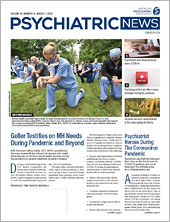Using data available from a nationwide study of children, researchers have calculated the first robust estimate of the prevalence of suicidal behaviors (including thoughts, plans, and attempts) among 9- and 10-year-olds in the United States. This analysis, which was published in Lancet Psychiatry, also identified key factors that both increase suicidal behaviors and help protect against them.
In that latter category, both positive parental engagement with children and having a positive school experience helped reduce the risk of suicidal behaviors by about 20%, while family conflicts and child psychological problems were associated with elevated risk of suicidal behavior.
These are not genetic risk factors or broad environmental risks that are difficult to modify, noted senior study author Sophia Frangou, M.D., Ph.D., a professor of psychiatry at the Icahn School of Medicine at Mount Sinai. “These are actionable items that are relevant to everyone and could lead to immediate results.”
Frangou and colleagues analyzed baseline data available from the National Institutes of Health–funded Adolescent Brain and Cognitive Development (ABCD) study. This study has enrolled over 10,000 children aged 9 and 10 from across the United States and is monitoring them for a decade to study teen brain development. As part of the baseline ABCD assessments, child participants and their parents separately completed a variety of questionnaires related to physical and mental health, including a survey on the child’s current or past suicidal behaviors. Complete data for both child and parental suicidality reports were available for 7,994 ABCD study participants.
Among children, 673 (8.4%) reported any past or current suicidal thoughts, 75 (0.9%) reported any past or current suicidal plans, and 107 (1.3%) reported past or current suicidal attempts. A total of 650 parents (8.1%) reported suicidal thoughts in their children, 46 (0.6%) reported suicidal plans, and 39 (0.5%) reported suicidal attempts. Though the overall rates look similar, Frangou highlighted that there was very little overlap between the child and parent reports; for example, only 198 children who reported suicidal thoughts were also identified as having these thoughts by their parents.
“This level of disagreement is concerning and suggests communication between caregivers and children about suicide is lacking,” Frangou told Psychiatric News. “From a clinical standpoint, the discordance also reinforces that just using parent reports on suicidal thoughts and behaviors in their children is not advisable.”
The research team then analyzed data from other family assessments and found that the presence of problem behaviors in children (such as aggression or antisocial behavior) and family conflicts reported by children were associated with an increased risk of suicidal behaviors in both boys and girls. Frangou stressed that the problem behaviors did not have to rise to the level of a psychiatric disorder to influence suicidality risk.
In contrast, more parental engagement and more positive school experiences were both associated with reduced risk of current or past suicidal behaviors in children. “Based on the reports, it was not just the absence of bullying that was important; what was protective was the children’s experience of their school as engaging and interesting,” Frangou said.
Frangou noted the significance of the findings in light of the COVID-19 pandemic, which has left millions of children nationwide out of school. “Experience from previous pandemics and emerging evidence from the current one point to increased domestic friction and spousal and child abuse when people are confined at home for extended periods,” she said.
The circumstances of this pandemic are amplified by the anxiety and uncertainty many families have over their immediate health and long-term financial prospects. It’s a volatile mix, but this study points to the important role that parents play in a child’s well-being.
“If parents can make the home environment engaging for children during this challenging time, it could also lead to positive outcomes.” ■
“Risk and Protective Factors for Childhood Suicidality: A U.S. Population-Based Study” is posted
here.

